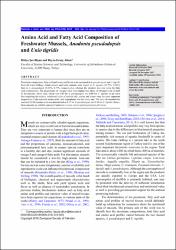| dc.contributor.author | Şereflişan, Hülya | |
| dc.contributor.author | Ersoy-Altun, Beyza | |
| dc.date.accessioned | 12.07.201910:50:10 | |
| dc.date.accessioned | 2019-07-12T22:06:00Z | |
| dc.date.available | 12.07.201910:50:10 | |
| dc.date.available | 2019-07-12T22:06:00Z | |
| dc.date.issued | 2018 | |
| dc.identifier.citation | Sereflisan, H., Ersoy-Altun, B. (2018). Amino acid and fatty acid composition of freshwater mussels, anodonta pseudodopsis and unio tigridis. Pakistan Journal of Zoology, 50(6), 2153-2158. doi: 10.17582/journal.pjz/2018.50.6.2153.2158 | en_US |
| dc.identifier.issn | 0030-9923 | |
| dc.identifier.uri | https://doi.org/10.17582/journal.pjz/2018.50.6.2153.2158 | |
| dc.identifier.uri | https://hdl.handle.net/20.500.12508/611 | |
| dc.description | WOS: 000455906200020 | en_US |
| dc.description | Science Citation Index Expanded | en_US |
| dc.description.abstract | Proximate composition, fatty acid and amino acid levels were measured in A. pseudodopsis and U. tigridis from the Lake Golbasi. Crude protein and lipid contents were higher in U. tigridis (10.75%, 0.96%) than in A. pseudodopsis (8.63%, 0.77%, respectively), whereas the situation was vise versa for fatty acid compositions. The proportions of Omega-3 (n3) were higher than those of Omega-6 (n6) in both of the mussels. n6/n3 ratio, which was 0.90 for A. pseudodopsis and 0.99 for U. tigridis, is an index for comparing the relative nutritional value of seafood oil. Leucine and lysine were the most important proportions of the essential amino acids, and tryptophane was the minor one. The ratio of essential/non essential (E/NE) amino acids was determined as 0.37 for A. pseudodopsis and 0.34 for U. tigridis. Hence, these mussels are reliable sources of nutrition to cover amino acid requirements of human. | en_US |
| dc.language.iso | eng | en_US |
| dc.publisher | University of Punjab (new Campus) | en_US |
| dc.relation.isversionof | 10.17582/journal.pjz/2018.50.6.2153.2158 | en_US |
| dc.rights | info:eu-repo/semantics/openAccess | en_US |
| dc.subject | Anodonta Pseudodopsis | en_US |
| dc.subject | Unio Tigridis | en_US |
| dc.subject | Fatty Acid | en_US |
| dc.subject | Eicosapentaenoic Acid (EPA) | en_US |
| dc.subject | Docosahexaenoic Acid (DHA) | en_US |
| dc.subject | Amino Acid | en_US |
| dc.subject.classification | Clams | Oysters | Biochemical composition | en_US |
| dc.subject.classification | Zoology | en_US |
| dc.subject.other | mytilus-galloprovincialis | en_US |
| dc.subject.other | proximate composition | en_US |
| dc.subject.other | chemical-composition | en_US |
| dc.subject.other | condition index | en_US |
| dc.subject.other | amino acid | en_US |
| dc.subject.other | bivalve | en_US |
| dc.subject.other | chemical compound | en_US |
| dc.subject.other | fatty acid | en_US |
| dc.subject.other | freshwater ecosystem | en_US |
| dc.subject.other | nutrition | en_US |
| dc.subject.other | protein | en_US |
| dc.subject.other | Anodonta | en_US |
| dc.subject.other | Unio | en_US |
| dc.title | Amino acid and fatty acid composition of freshwater mussels, anodonta pseudodopsis and unio tigridis | en_US |
| dc.type | article | en_US |
| dc.relation.journal | Pakistan Journal of Zoology | en_US |
| dc.contributor.department | Deniz Bilimleri ve Teknolojisi Fakültesi | en_US |
| dc.identifier.volume | 50 | en_US |
| dc.identifier.issue | 6 | en_US |
| dc.identifier.startpage | 2153 | en_US |
| dc.identifier.endpage | 2158 | en_US |
| dc.relation.publicationcategory | Makale - Uluslararası Hakemli Dergi - Kurum Öğretim Elemanı | en_US |
| dc.contributor.isteauthor | Şereflişan, Hülya | |
| dc.contributor.isteauthor | Ersoy-Altun, Beyza | |
| dc.relation.index | Web of Science (ESCI) - Scopus | en_US |
















